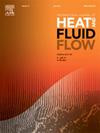A divide-and-conquer deep learning approach to reconstruct flow and temperature fields
IF 2.6
3区 工程技术
Q2 ENGINEERING, MECHANICAL
International Journal of Heat and Fluid Flow
Pub Date : 2024-12-24
DOI:10.1016/j.ijheatfluidflow.2024.109707
引用次数: 0
Abstract
Reconstructing flow and temperature fields from limited sensor measurements is a critical capability for state evaluation, optimization, and control of flow and heat transfer processes. While deep learning has been harnessed for physical field reconstruction and has demonstrated impressive performance, it faces the challenge of achieving enhanced precision and computational efficiency, particularly when dealing with intricate, nonlinear problems. Inspired by the observation that numerous physical phenomena exhibit distinct behaviors within isolated regions of the spatial domain, such as boundary layers and separated flows, we introduce a novel deep learning approach that employs a “divide-and-conquer” strategy. In this methodology, the entire spatial domain is partitioned into various subdomains, each of which is entrusted to a dedicated neural network for precise reconstruction of the flow and temperature fields. Initially, the physical domain is segmented into discrete subdomains using K-means clustering based on cosine distance. Subsequently, individual deep neural networks are constructed to map from limited sensor measurements to the physical field within each subdomain. Finally, the separately reconstructed fields are amalgamated to constitute the ultimate physical field representation. To validate the efficacy of our approach, numerical experiments were conducted across four diverse cases: flow around a cylinder, turbulent channel flow, transonic flow, and conduction involving multiple heat sources. The results demonstrate the superior accuracy and efficiency of the proposed method. In comparison to the non-partitioned approach, our method achieves a minimum reduction of 44.6% in mean absolute error, simultaneously enhancing training efficiency by approximately 30.0% under the premise that the model can utilize multi-GPUs parallel training, all while maintaining a manageable model complexity.
求助全文
约1分钟内获得全文
求助全文
来源期刊

International Journal of Heat and Fluid Flow
工程技术-工程:机械
CiteScore
5.00
自引率
7.70%
发文量
131
审稿时长
33 days
期刊介绍:
The International Journal of Heat and Fluid Flow welcomes high-quality original contributions on experimental, computational, and physical aspects of convective heat transfer and fluid dynamics relevant to engineering or the environment, including multiphase and microscale flows.
Papers reporting the application of these disciplines to design and development, with emphasis on new technological fields, are also welcomed. Some of these new fields include microscale electronic and mechanical systems; medical and biological systems; and thermal and flow control in both the internal and external environment.
 求助内容:
求助内容: 应助结果提醒方式:
应助结果提醒方式:


